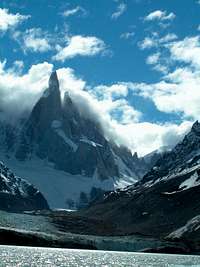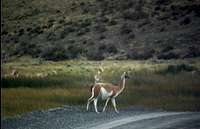|
|
Area/Range |
|---|---|
|
|
49°S / 73°W |
|
|
Hiking, Mountaineering, Trad Climbing, Sport Climbing, Ice Climbing, Big Wall, Skiing |
|
|
Spring, Summer, Fall, Winter |
|
|
The Patagonian Andes
Patagonia - a region covering almost half a continent and about 800000 km2. It is the southern part of South America, approximately south of Monte San Lorenzo (around 47°S), covering southern parts of Chile and Argentina. On the Chilean side, Patagonia is considered to begin south of the city of Puerto Montt and in Argentina it begins south of the Colorado River, which includes Bariloche and the Valdés Peninsula. Patagonia ends at Tierra del Fuego, the southern extreme of South America.
Most parts of Patagonia, that is the regions east of the Andes, are steppe-like plains of scarce vegetation. The Patagonian Andes are located basically along the border between Chile and Argentina and serve as a water shend and climate barrier causing the dry climate of the eastern plains of Patagonia. Most rivers of Patagonia are fed by the glaciers of the Patagonian Andes and the Patagonian Ice Fields.
Patagonia in general is famous for its strong and fierce winds. These strong winds, mostly coming from north-western directions from the Pacific Ocean. Thus the humidity in the air is precipitated on the western side of the Patagonian Andes, causing severe snow storms all year round. In contrast the air reaching the east side of the Patagonian Andes is low in humidity causing a semi-arid climate in the eastern Patagonian plains. In turn, air rising over the hot plains of east Patagonia induce the strong wind falling from the Andes during day time.
The Patagonian Andes are not as high as in the northern part of Chile and Bolivia. The highest peaks include Fitz Roy (3405m) in Argentina, and San Valentin (4058m) in Chile.
The ten highest peaks of the Patagonian Andes are:
| Peak name | altitude (m) |
| Cerro San Valentín | 3910 |
| Monte San Lorenzo | 3706 |
| Monte Mariano Moreno | 3393 |
| Volcano Lautaro | 3380 |
| Fitz Roy | 3375 |
| Cerro Bertrand | 3270 |
| Cerro Agassiz | 3180 |
| Cerro Torre | 3128 |
| Torre Egger | 2987 |
| Monte Maca | 2958 |
| Cerro Murallón | 2831 |
| Cerro Grande | 2804 |
The most famous and popular trekking and mountaineering regions in Patagonia are
Parque Nacional Torres del Paine: Great cricuit trek around the Torres del Paine, as well a challenging climbing opportunities.
Parque Nacional Los Glaciales: One can visit the mighty Moreno Glacier as well as the famous mountains Fitz Roy and Cerro Torre.
The Patagonian Ice Fields
There are two large ice fields in Patagonia, which constitute the largest continuous mass of ice outsisde the polar regions, and the glaciers draining form the icefields extend to lower latitudes than those of any other substantial ice mass in the world. Characteristic for both icefields is abundant nourishing precipitation, high ablation rates and high ice velocities.
The Northern Patagonian Ice Field (Campos de Hielo Norte) is located in Chile (centered near 47°0′S 73°30′W). It is the smaller of two Patagonian Ice Sheets, and it is a remnant of a more extensive ice sheet that had covered much of Patagonia over a million years ago. Today it coveras an area of 4200 km2 at altitudes between 1100 m and 1500 m, ice thickness reaches 1400 m. The Norther Ice Field has over 40 exit glaciers, the largest two — San Quintin and San Rafael — almost reach sea level at the west side towards the Pacific Ocean.
The Southern Patagonian Icefield (Campos de Hielo Sur) covers a surface of around 13000 km2. It is over 350 km long, with an average width of 40 km and ice thickness are also greater than 1000 m. The Southern Icefield discharges via more than 60 outlet glaciers, the most famous one is Moreno Glacier. Moreno Glacier is one of the biggest and most impressive glaciers in Patagonia and it is unique as it is still one of the worlds few advancing glaciers - its up to 400m high ice front advances at 1 to 5 m a day leading to a high rate of calving. In the past the glacier used to advance until completely blocking the river beneath it until the waters crashed their way through the glacier again. This leads to a approximately 2 day event of huge glacier parts crashing into the waters. This phenomenon, however, hasn't occurred in 16 years, until the year 2004 when the glacier had advanced once again, and completely blocked the river.
The longitudinal traverse of the Southern Patagonian Icefield had remaind a challenge for a long time - the Patagonian weather conditions made it especially challenging. Only in 1999 a team led by Pablo Bessler managed the unsupported north-to-south crossing of the Campo Hielo Sur.
Wildlife
The guanaco is a very characterisitc animal of the Patagonian plains. The guanaco roam in herds over the country and were a major source of subsistence for the natives, who used to hunt them on horseback with dogs and bolas.
There are great opportunities for bird-watching in Patagonia: The carrion-hawk is one of the characteristic objects of a Patagonian landscape, in the forest one can see the pretty Patagonian woodpecker. The presence of long-tailed green parakeets as far south as the shores of the Magellan strait attracted the attention already of the earlier navigators, and hummingbirds may be seen flying amidst the falling snow. Among the characteristic water birds are the flamingo, the Magellan goose, and in the Magellan strait one can observe the filghts of the albatros. In the Patagonian Andes one can also observe the condor circling.
In the forests, the predominant tree species are the southern beech species Nothofagus pumilio (lenga) and the Nothofagus betuloides (guindo).








Igor Czs - Aug 22, 2006 11:36 am - Hasn't voted
Hihgest peak patagonia surHi! Let me contribute whith some information. Actualy,Monte San Valentin (aka San Clemente) had his altitude accurated to 3910 mts, it's still the highest peak in Patagonia Sur, not including Lake district and Bariloche/Volcan Lanin area, followed by Cerro San Lorenzo,3706mts. Fitz Roy coul'd be considered the third, folowed by the two remote peaks inside campo de hielo sur (south patagonia ice cap) Mount Mariano Moreno (3393mts) and Volcano Lautaro 3380 (activity was experienced by British climber John Biggar).Some sources claim Volcan Domuyo, 4700mts as the highest peak in Patagonia...but Technically, Patagonia beggins at the latitude of Monte San Lorenzo... Cheers Igor Czs- Brazil
waltraud - Aug 25, 2006 7:14 am - Hasn't voted
Re: Hihgest peak patagonia surHi Igor, thanks for the additional information/corrections. I will update the page accordingly. Waltraud
Igor Czs - Sep 3, 2006 3:42 pm - Hasn't voted
Highest peak patagonia surHi Waultraud, If you need any information, i'll be glada to help you... If possible, tell me more about your stormy experience on Volcan Chachani, Arequipa....I'm planning to climb this peak October and El Misti also. Cheers Igor
Nikman - Dec 31, 2007 7:04 am - Hasn't voted
Cerro San Valentin (4.058m)There is some confusion about the elevation. It was originally estimated 3.876m by Nordenskjold in 1921 but later thought to be 4.058m. The latter is the most commonly quoted elevation and should also be quoted here. A French group climbed the San Valentin in 1993 and included two surveyors, who calculated an elevation of 4.080±20 m using a GPS. In 2001 a Chilean group measured 4.070±40 m during the ascent using a GPS. SRTM data also supports an elevation above 4.000 meters, but the Chilean IGM map quotes only 3.910 metres. ChIGM maps are usually reliable, but the summit is uniformly white, which may have created problems for the cartographers.
Baarb - Jan 29, 2012 5:24 pm - Hasn't voted
Another rangeJust found the Cordillera Darwin Area/Range page (http://www.summitpost.org/cordillera-darwin/561431), it would be good to make it a Child to this Patagonia page. Thanks.